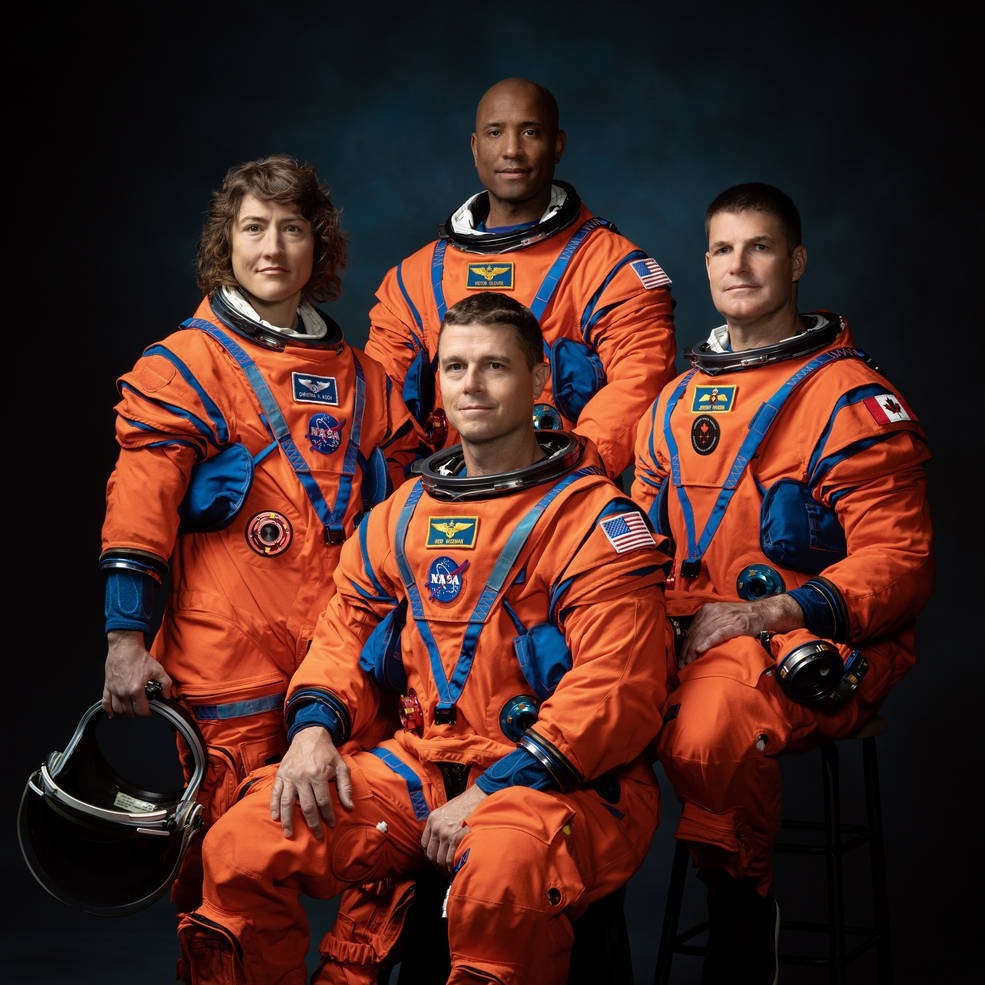Having successfully completed phase one of its Artemis program in December, NASA has recently announced its new crew intentions for Artemis II. The crew, consisting of Christina Koch, Reid Wiseman, Victor Glover, and Canadian Space Agency astronaut Jeremy Hansen, will embark on a 10-day flight test to ascertain and validate the conditions for a future moon landing and plans for humans to live and work in deep space.

Image Credit: NASA
The four-member team could launch early as 2024 on the first crewed voyage to fly by the moon in over 50 years.
The crew, led by Commander Reid Wisemen, includes Christina Koch and Victor Glover, the first female, and first African American astronauts ever to be named as part of a lunar mission. The mission also represents a collaboration between the Canadian Space Agency (CSA) as Canadian Jeremy Hansen is also part of the crew.
The Artemis II crew represents thousands of people working tirelessly to bring us to the stars. This is their crew, this is our crew, this is humanity’s crew… Each has their own story, but, together, they represent our creed: E pluribus unum – out of many, one. Together, we are ushering in a new era of exploration for a new generation of star sailors and dreamers – the Artemis Generation.
NASA Administrator Bill Nelson
The Artemis Crew
Having ascended through the ranks as a US Navy Aviator and fighter pilot into NASA’s class of 2013, Glover will pilot the Artemis II mission.
Glover has previous experience on spaceflight missions, having been a part of the SpaceX Dragon Crew-I mission, which lasted 168 days in orbit and was SpaceX’s first collaboration with NASA’s operations on the ISS (International Space Station).
Koch, also a class of 2013 astronaut and record holder for the longest continuous spaceflight completed by a woman, has been assigned the role of Mission Specialist 1.
Artemis II will mark her second venture into space after a successful mission to the ISS, where she also took part in the first all-female spacewalk, with Jessica Meir, outside the space station in 2019.
During her career, Koch also worked as an electrical engineer at NASA’s Goddard Centre in Maryland and has helped develop advanced robotics for previous NASA missions.
Reid Wiseman and Jeremy Hansen will act respectfully as mission Commander and Mission Specialist 2. Wiseman has been with NASA after being recruited as part of its class of 2009 and has served on ISS expeditions 40 and 41. Wiseman, previously a naval fighter pilot, also held the position of NASA’s Chief of Astronaut office and has been instrumental in the development of the Artemis program.
Hansen, a Canadian astronaut and member of the Canadian Space Agency (CSA), also progressed through the military, having served in Royal Canadian Air Force. Colonel Hansen was recruited as a CSA astronaut in 2009 and was part of the European Space Agency’s (ESA) subterranean CAVES program as well as its underwater NEEMO expedition.
We are going back to the Moon and Canada is at the center of this exciting journey… Canada’s participation in the Artemis program is not only a defining chapter of our history in space, but also a testament to the friendship and close partnership between our two nations.
Honorable François-Philippe Champagne, the Minister Responsible for the Canadian Space Agency
An Outpost to Mars
The Artemis program is part of NASA’s larger ambition of bridging the gap between Earth and Mars. These missions represent a stepping stone in NASA’s history as the first lunar missions since 1972. The aim is to test advanced technologies to help explore more of the moon’s surface with the goal of venturing further into the solar system.
NASA aims to work with international and commercial partners to develop what it calls a “sustainable outpost” as a long-term human presence on the moon. This outpost would then test the capacity for human endurance in deep-space missions as well as act as a launch pad for future missions to Mars.
In addition to testing spacecraft and sending humans back towards the moon, the Artemis program incorporates robotics and other innovative technologies to help find and potentially recover resources such as water that can be transformed into other key resources, such as fuel and oxygen.
While the early phases of the Artemis program have involved the use of commercial rockets and NASA’s Space Launch System, the Orion crew capsule, and a commercial lunar landing system, Mars remains the long-term goal.
By making improvements to landing technologies as well as designing new mobility systems, NASA believes that astronauts will be able to travel farther distances in the near future.
References and Further Reading
O’Shea, C. (2023) NASA names astronauts to next Moon mission, first crew under Artemis, NASA. NASA. Available at: https://www.nasa.gov/press-release/nasa-names-astronauts-to-next-moon-mission-first-crew-under-artemis
Disclaimer: The views expressed here are those of the author expressed in their private capacity and do not necessarily represent the views of AZoM.com Limited T/A AZoNetwork the owner and operator of this website. This disclaimer forms part of the Terms and conditions of use of this website.